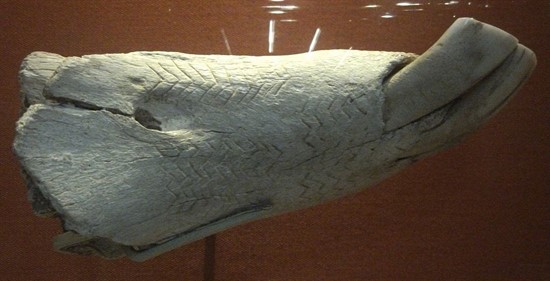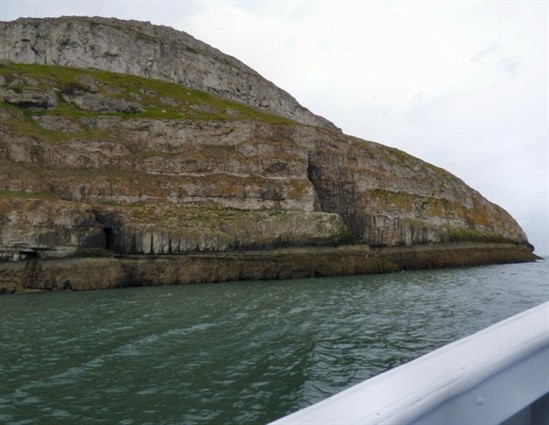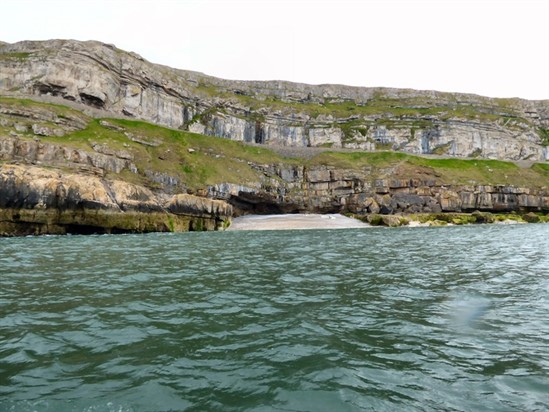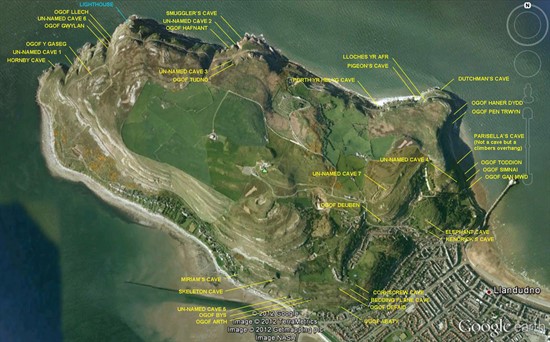Posted on 21/03/2024 by Thom
You've probably already heard of the Great Orme's incredible prehistoric copper mines, but what of its many limestone caves? Many are tricky to access but they all have a fascinating story to tell, from sheltering families and shipwrecked souls, to giving up startling secrets including the oldest piece of art ever found in Britain.
Here's our guide to the Great Orme's caves, following the anti-clockwise route of the tolled Marine Drive - from Happy Valley to West Shore. There are plenty of places to stop along the way where you can look out for these caves, but some are only visible from the sea (read on to learn about round-the-Orme boat trips).
Note: Where we give map co-ordinates it is possible to reach these caves from land with care.
Kendrick's Cave (Upper): SH 780 828
Although not accessible to the public (its gated entrance can be found off Ty Gwyn Road which leads onto the Great Orme Summit road - approach from the west across waste land lying just above the road), Kendrick's Cave has revealed some of the most amazing archeological finds in the UK.
It's named after Thomas Kendrick, a copper miner-turned artisan, who found an engraved fragment of horse jawbone in the cave in 1879. The bone has since been dated back to between 10,000 and 11,000 BC, making it the oldest artwork ever discover in Britain.
This artefact and many others found on the Orme are on display at the British Museum, while other items can be seen at Llandudno Museum on Gloddaeth Street.

Ogof Hanner Dydd (The Midday Cave)
Thought to be so named because at Spring Equinox the midday sun shines right to the back of the cave. You will need climbing experience to access it, found between the Happy Valley Toll Gate and Pentrwyn Headland, below Marine Drive.
There are several smaller caves above the road just past the Toll Gate too, where you'll often find people practicing their climbing and bouldering skills.

Ogof Colomenriod (Pigeons' Cave): SH 778 838
In a quarry where stone was produced for Telford's suspension bridge over the Menai Strait, Pigeons' Cave is below the road and one of the easiest caves to access from the sea.
This bouldery beach also has rock formations with evocative names like Frog's Head and Austen's Rock, both of which again are best viewed from a boat.
To see the cave, park on Marine Drive directly beneath a large overhang. Directly opposite is a gap in the cliff wall where an indistinct path leads down to a broad limestone shelf about 10 metres above sea level. Follow this shelf to the left for about 30m and you'll see the rock shelter of Pigeon's Cave ahead.
Warning: you will need climbing equipment to get down to the beach.

Ogof Tudno (Badger Cave): SH 764 841
Although some passages in Badger Cave look like natural caves, it is possible that this entire cave system is the result of ancient mining of mineral-rich 'flats' or 'pipes'. The main (most westerly) entrance is about 3m x 3m and leads to a series of passages.
Take care and do not disturb this cave system as it is believed archaeological remains may still be found here.
Ogof Llech (The Monk's Cave)
One of the most intriguing of the Orme's caves, but unfortunately only accessible via boat or climbing equipment. The walls of the cave are lined with sandstone, not a local stone, to form an octagonal chamber. There's also a sandstone seat, a table and outside the weathered statue believed to be of an angel.
This has linked the cave to St Tudno, a Welsh monk, the Knights of St John Jerusalem, and more recently (and maybe more believably) the Mostyn family, who owned much of Llandudno and the Great Orme.
They may have certainly repaired the cave, making it more difficult to know what it's original purpose may have been. Finally, it sheltered escaped German POWs during the Second World War. For a small cave, Ogof Llech has many stories to tell!
Hornby Cave
Like many caves and coves across North Wales, Hornby Cave takes its name from a shipwreck. The brig Hornby sank here in a gale on New Year's Day in 1824.
There was only one survivor, who managed to climb into the cave and up the cliffs to take refuge in a mine smithy. Again, this cave is impossible to access by land and only by boat with an experienced skipper.
There are at least 7 un-named caves on the Great Orme that we know of. Experts also believe there may be many more caves yet undiscovered and explored.
For the best way to view the Orme's many seaward caves, hop on board Llandudno Boat Trips' launch from the town's North Shore jetty. For details and bookings call 07961 561589. Trips run daily until the end of October, weather permitting.

Images courtesy: Midday Cave and Pigeon'a Cave by Gerald England. Kendrick's Cave prehistoric horse jawbone by By Johnbod (Own work) via Wikimedia Commons. Map of Great orme caves courtesy of Googlemaps via https://sites.google.com/site/cavesofnorthwales/11-caves-of-llandudno.

